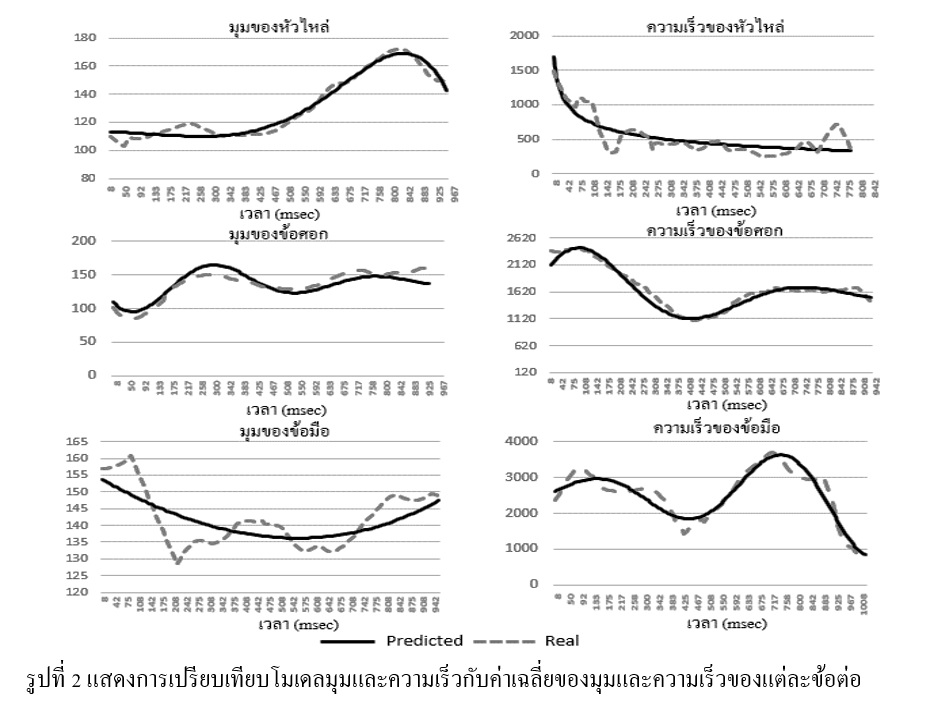การเปลี่ยนแปลงของตัวแปรทางชีวกลศาสตร์ของการว่ายน้ำ 200 เมตร ท่าฟรอนท์ครอลในรยางค์ส่วนบนของนักกีฬาว่ายน้ำทีมชาติไทย
Main Article Content
บทคัดย่อ
วัตถุประสงค์ : เพื่อเปรียบเทียบการเปลี่ยนแปลงของตัวแปรทางชีวกลศาสตร์ของนักกีฬาว่ายน้ำท่าฟรอนท์ครอลที่ในระยะทาง 200 เมตร
วิธีดำเนินการวิจัย : กลุ่มตัวอย่างเป็นนักกีฬาว่ายน้ำท่าฟรอนท์ครอลทีมชาติไทยเพศชายที่เข้าร่วมการแข่งขันกีฬาซีเกมส์ครั้งที่ 29 ณ ประเทศมาเลเซีย ปี 2560 จำนวน 7 คน การวิเคราะห์การเปลี่ยนแปลงของตัวแปรทางชีวกลศาสตร์ โดยใช้ชุดกล้องวิเคราะห์ การเคลื่อนไหวทั้งบนบกและใต้น้ำรวม 16 ตัว ในการเก็บข้อมูลในอุโมงค์น้ำ ที่คณะวิทยาศาสตร์การกีฬา จุฬาลงกรณ์มหาวิทยาลัย โดยให้กลุ่มตัวอย่างทุกคนใส่ชุดว่ายน้ำติดมาร์คเกอร์ แล้วว่ายน้ำท่าฟรอนท์ครอล ระยะ 200 เมตร ที่ความเร็ว 75% ของความเร็ว สูงสุดที่ว่ายในสระว่ายน้ำ วิเคราะห์ตัวแปรมุมและความเร็วเชิงเส้นของข้อต่อ จากนั้นนำมาเปรียบเทียบความแตกต่างที่ระยะต่างๆ 5 ช่วง คือ 15-35 เมตร 65-85 เมตร 115-135 เมตร และ 196-200 เมตร ตามลำดับ
ผลการวิจัย : พบว่า ค่าเฉลี่ยของมุมหัวไหล่และข้อมือในระยะ 15-35 เมตร มีความแตกต่างจากระยะ 195-200 เมตร และค่าเฉลี่ยความเร็วของหัวไหล่ ข้อศอก และข้อมือ ลดลงในช่วงระยะ 15-35 เมตร กับช่วงระยะ 195-200 เมตร อย่างมีนัยสำคัญทางสถิติที่ .05 การจำลองวิถีมุมและความเร็วของข้อต่อด้วย สมการพยากรณ์การเคลื่อนที่แบบ Simple Harmonic Motion สามารถพยากรณ์ ค่าเฉลี่ยของการเคลื่อนที่ได้ถูกต้องมากกว่าร้อยละ 80 โดยพบว่า เวลาที่ใช้ในการเคลื่อนที่ให้ครบรอบเพิ่มขึ้น เมื่อระยะว่ายเปลี่ยนแปลงไป
สรุปผลการวิจัย : การว่ายท่าฟรอนท์ครอลระยะ 200 เมตร ส่งผลต่อการเปลี่ยนแปลงของมุมการเคลื่อนไหวของแต่ละข้อต่อช่วงบนกับเวลา เมื่อระยะทางที่ว่ายเพิ่มขึ้น รูปแบบการเคลื่อนที่ของข้อต่อเหมือนเดิม แต่เวลาในการเคลื่อนที่ของข้อต่อจะแตกต่างกันไป จากการวิเคราะห์ด้วยสมการพยากรณ์แบบ Simple Harmonic Motion พบว่า เมื่อระยะทางเพิ่มขึ้น เวลาการเคลื่อนที่ของข้อต่อในแต่ละสโตรกเพิ่มขึ้น ความเร็วเฉลี่ยของแต่ละข้อต่อลดลง
Article Details
References
Alberty, M., Potdevin, F., Dekerle, J., Pelayo, P., Gorce, P. and Sidney, M. (2008). Changes in swimming technique during time to exhaustion at freely chosen and controlled stroke rates. Journal of Sports Sciences, 26(11), 1191-1200.
Alberty, M., Sidney, M., Huot-Marchand, F., Hespel, J. and Pelayo, P. (2005). Intracyclic velocity variations and arm coordination during exhaustive exercise in front crawl stroke. International Journal of Sports Medicine, 26(06), 471-475.
Allen, D. G., Lamb, G. D. and Westerblad, H. (2008). Skeletal muscle fatigue: cellular mechanisms. Physiological Reviews, 88(1), 287-332.
Aujouannet, Y. A., Bonifazi, M., Hintzy, F., Vuillerme, N. and Rouard, A. H. (2006). Effects of a high-intensity swim test on kinematic parametress in high-level athletes. Applied Physiology, Nutrition, and Metabolism, 31(2), 150-158.
Barbosa, T. M., Fernandes, R., Keskinen, K., Colašo, P., Cardoso, C., Silva, J. and Vilas-Boas, J. (2006). Evaluation of the energy expenditure in competitive swimming strokes. International Journal of Sports Medicine, 27(11), 894-899.
Berger, M. A. (1999). Determining propulsive force in front crawl swimming: a comparison of two methods. Journal of Sports Sciences, 17(2), 97-105.
Callaway, A. J. (2015). Measuring Kinematic Variables in Front Crawl Swimming Using Accelerometress: A Validation Study. Sensors, 15(5), 11363-11386.
Ceccon, S., Ceseracciu, E., Sawacha, Z., Gatta, G., Cortesi, M., Cobelli, C., & Fantozzi, S. (2013). Motion analysis of front crawl swimming applying CAST technique by means of automatic tracking. Journal of Sports Sciences, 31(3), 276-287.
Craig, A. B., Skehan, P. L., Pawelczyk, J. A. and Boomer, W. L. (1985). Velocity, stroke rate, and distance per stroke during elite swimming competition. Medicine and Science in Sports and Exercise 17(6), 625-634.
Chollet, D., Delaplace, C., Pelayo, P., Tourny, C., & Sidney, M. (1997). Stroking characteristic variations in the 100-m freestyle for male swimmers of differing skill. Perceptual and Motor Skills, 85(1), 167-177.
Deschodt, V., Arsac, L. and Rouard, A. (1999). Relative contribution of arms and legs in humans to propulsion in 25-m sprint front-crawl swimming. European Journal of Applied Physiology and Occupational Physiology, 80(3), 192-199
Deschodt, V. J. and Arsac, L. M. (2004). Morning vs. evening maximal cycle power and technical swimming ability. The Journal of Strength & Conditioning Research, 18(1), 149-154.
Figueiredo, P., Pendergast, D. R., Vilas-Boas, J. P. and Fernandes, R. J. (2013). Interplay of biomechanical, energetic, coordinative, and muscular factors in a 200 m front crawl swim. BioMed Research International.
Gourgoulis, V., Antoniou, P., Aggeloussis, N., Mavridis, G., Kasimatis, P., Vezos, N., Mavromatis, G. (2010). Kinematic characteristics of the stroke and orientation of the hand during front crawl resisted swimming. Journal of Sports Sciences, 28 (11), 1165-1173.
Kachaunov, M. (2018). Post-Competition blood lactate concentration in swimmers. Journal of Applied Sports Sciences, 1, 30-36.
Laffite, L. P., Vilas-Boas, J. P., Demarle, A., Silva, J., Fernandes, R. and Louise Billat, V. (2004). Changes in physiological and stroke parametress during a maximal 400-m free swimming test in elite swimmers. Canadian Journal of Applied Physiology, 29(S1), S17-S31.
Psycharakis, S. G. and Sanders, R. H. (2008). Shoulder and hip roll changes during 200-m front crawl swimming. Medicine and Science in Sports and Exercise, 40 (12), 2129-2136.
Pyne, D. B., Lee, H. and Swanwick, K. M. (2001). Monitoring the lactate threshold in world-ranked swimmers. Medicine and Science in Sports and Exercise, 33(2), 291-297.
Sanders, R. H. (1999). Hydrodynamic characteristics of a swimmer’s hand. Journal of Applied Biomechanics, 15(1), 3-26.
Tella, V., Toca-Herrera, J., Gallach, J., Benavent, J., González, L. and Arellano, R. (2008). Effect of fatigue on the intra-cycle acceleration in front crawl swimming: A time frequency analysis. Journal of Biomechanics, 41(1), 86-92.
Toussaint, H. and Truijens, M. (2005). Biomechanical aspects of peak performance in human swimming. Animal Biology, 55(1), 17-40.
Toussaint, H. M. (1990). Differences in propelling efficiency between competitive and triathlon swimmers. Medicine and Science in Sports and Exercise, 22(3), 409-415.
Toussaint, H. M., Carol, A., Kranenborg, H. and Truijens, M. J. (2006). Effect of fatigue on stroking characteristics in an arms-only 100-m front-crawl race. Medicine and Science in Sports and Exercise, 38(9), 1635-1642.
Toussaint, H. M., Van den Berg, C., & Beek, W. J. (2002). “ Pumped-up propulsion” during front crawl swimming. Medicine and Science in Sports and Exercise, 34(2), 314-319.
Vescovi, J. D., Falenchuk, O., & Wells, G. D. (2011). Blood lactate concentration and clearance in elite swimmers during competition. International Journal of Sports Physiology and Performance, 6(1), 106-117.
Wu, G., Van der Helm, F. C., Veeger, H. D., Makhsous, M., Van Roy, P., Anglin, C., Wang, X. (2005). ISB recommendation on definitions of joint coordinate systems of various joints for the reporting of human joint motion-Part II: shoulder, elbow, wrist and hand. Journal of Biomechanics, 38(5), 981-992.

